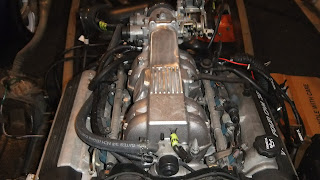The idea is Robin will be able to have it on display at the event all weekend and I will take it home afterwards. Robin thought that would work for them, so things got underway.
Here are the first pics of the progress. I am no expert on the process but I'll do my best to explain it to you.
What you see in this first picture is the mould. It is taken off an original car and is made in sections that bolt together. In the picture the mould is upside down (on its roof) and the big opening closest to you is the drivers door frame. To the left is the front (firewall) and to the right is the back (boot or trunk).
If you double click on the picture you will see a larger version and you might be able to pick up the bolts running along the top of the windscreen (remember its upside down) and a few other places if you look closely.
The shiny black finish is the surface that the fibreglass will be laid up onto. Before this happens though it is coated with a releasing agent so that the fibreglass body doesn't stick to the mould. You can also see a bit of grey towards the back.....that is the finished colour of my body being brushed on. It seems weird that it goes on first and that it is being brushed on, but what happens is that finish (gelcoat) is making contact with the the very smooth and shiny mould so it will come out looking smooth and shiny like that too. Any brush marks will be on the underside where the fibreglass will be layered.
Here's another angle. You are looking through from the engine bay towards the back of the car. The small shaped opening right in the middle of the picture is the back window.
Here the gelcoat has been applied to the entire mould.
Now that the gelcoat has been applied, the fibreglass starts to get laid. It is basically a cloth made of thousands of glass strands. Resin is then brushed onto the cloth and worked in with brushes and rollers so that it soaks the fibreglass cloth.
The resin is a two part mix of resin with a hardener. The mix is quite critical. Not enough hardener and it won't set. Too much and it will go hard before you can work it into the mat properly and before you have a chance to use it at all. In extreme cases the reaction will happen so fast that heat builds up and it starts to fizzle pop and smoke.
The hole you can see the floor through is where they had a canvas roof insert in the original car. I will either close this up or I might even fit a sunroof.
This is looking out through the boot opening.
In these next pictures you can see a different colour mat has been applied. This is a very tightly bound mat that gives the body strength.
The furry edge in this next picture is where the fibreglass has been laid over the edge of the mould. This gives you a good idea of what the fibreglass matting looks like in its raw state. In fact if you look at the front edge of the door opening you can see a rectangular strip laying there.
That same furry edge has been trimmed in this next picture.
As you can see progress on the body is well underway. This fibreglass is layered again and again to build up the desired thickness, so Robin will keep doing this for a while yet. More pictures to follow I believe.
In the meantime click on this link to see their website Koop de Glass. You will be able to see some of their other products and some cars that have been created from their products. Remember that white 33 Ford Coupe I had before selling it so I could fund this project? It came out of this very same mould!
Thanks Robin and Lynda for sending the pics through. Looking good!!



















































